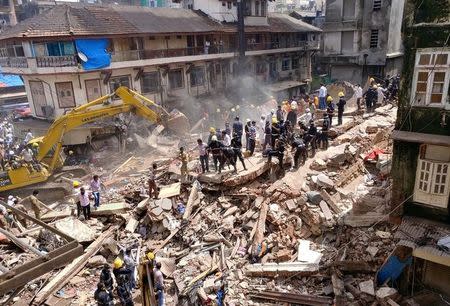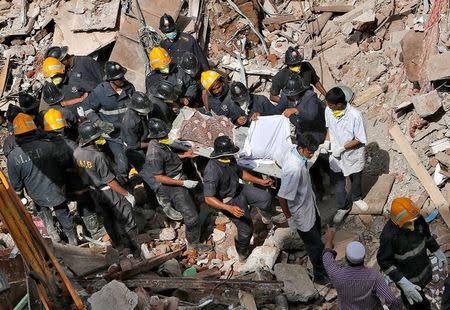Defying warnings, residents refuse to leave Mumbai's crumbling buildings
By Swati Bhat and Rajendra Jadhav MUMBAI (Reuters) - On a sunny morning last week in Mumbai after two days of incessant monsoon rain, Mohammad Altaf had come out of his home for a cigarette when he heard a terrifying crash, followed by a huge swirl of dust. The six-storey Husainee building where he had lived for the last month had collapsed, trapping nearly 50 people. Thirty-four of them were killed, including a newborn baby. "It was shocking. I had come down for a smoke, and within two minutes the building was no more," said Altaf, who says he was unaware the apartment block was declared unsafe by housing authorities in India's financial hub six years ago. Across the teeming city of 20 million people, thousands of families live in crumbling buildings that have been officially declared uninhabitable - and most of them know it. Housing officials say they cannot be forced out because of lax laws. This year, the city's municipal corporation classified 791 buildings as beyond repair and too dangerous to live in, but close to 500 of these continue to be occupied, a municipal authority official said. Although regulations vary from country to country and also from state to state, authorities in most places have more powers to order evacuations. Altaf, in his mid-thirties, is a bachelor and was living with two co-workers in the apartment in the Bhendi Bazar locality, one of the oldest in the metropolis. His two flatmates survived, with minor knee and shoulder injuries, after jumping out of their apartment on the third floor. Police say they have yet to determine the cause of the collapse, which came after days of intense rain. The 117-year-old apartment block in Bhendi Bazar, a packed neighbourhood of narrow streets, shops and tenements, was declared unsafe in 2011 by the regulator, the Maharashtra Housing and Area Development Authority (MHADA). Yet it continued to house Altaf and his flatmates, along with five other families, a sweet shop warehouse and even a nursery on the first floor. The owner of the building, Hakimmudin Bootwala, said seven families moved out by 2014, but other tenants refused despite his urging. One of them had sub-let the apartment to Altaf and his colleagues. "The people were my friends and neighbours first, and tenants later," said the 73-year-old. "I sincerely advised them to move out. The building had lots of problems, leakages. The roof was fine, but the walls had become really weak and porous." LOOPHOLES An official at MHADA said there was a law to force residents to evacuate dangerous buildings but enforcing it was impossible because of loopholes and legal challenges. For instance, evicting children and senior citizens could cause trouble, said the housing official, who declined to be identified because he was not authorised to speak to the press. "We cut water and electricity supply of buildings that are identified as dangerous for living, but people manage to get water and electricity from nearby buildings," said the official. MHADA, which does a routine check of buildings that are older than 30 years, has identified more than 14,000 buildings in the city that need repair, according to its latest list. Nine thousand of these, home to nearly 250,000 families, need to be redeveloped, the housing official said, adding that the other 5,000 were relatively safe due to regular maintenance work done by landowners in consultation with the housing body. Once regulators decide a building needs to redeveloped, they have to appoint a developer to renovate or rebuild the structure in the case of public housing, or order private owners to hire one. The developer, in turn, must offer residents alternative accommodation until the work is completed, according to state law in Mumbai. But residents often complain the housing they are offered is too small, shabby or too far away. Seventy percent of tenants of both privately- and publicly-owned buildings must agree to redevelop their building according to state rules, or no redevelopment work can commence. Building owners say residents are often unrealistic, refusing to leave even if the alternative housing is adequate. Some worry they could lose their tenancy if they move. The MHADA official said the agency does everything it can to get residents and developers to clinch an agreement, but that the process often gets mired in legal challenges. REFUSING TO MOVE The problems of the Husainee building were typical. A neighbourhood body, the Saifee Burhani Upliftment Trust, had been selected by its owner in 2009 to redevelop the building along with other buildings in the neighbourhood, even before the Husainee had been declared unsafe by MHADA. A trust official told Reuters it offered alternative housing to the residents in a place around 2.5 km (1.5 miles) from the building. The official said the trust repeated the offer in 2011 after MHADA declared the building unsafe. A Reuters team visited the complex where the Husainee families who had agreed to move had been relocated, a gated high-rise complex with guards and a playground for kids. Residents said they were happy with their new apartments, although they complained about the distance to work. But other Husainee families refused to move. MHADA officials said the trust was in charge of ensuring relocation and redevelopment and MHADA could not force the Husainee families to leave. The trust has said it has repeatedly tried to evict families from Husainee but some residents refused to move. "This incident should be a wake-up call for the city, and a policy needs to be actioned to evict non-cooperating tenants who continue to live in dilapidated buildings," the trust said in a written reply to Reuters queries. Building owner Bootwala says the residents who refused to leave argued they did not want to upend their lives by moving to a new neighbourhood. Also, they did not know how long it would take to renovate the building. Reuters was unable to talk to other residents from Husainee, but neighbours in Bhendi Bazar told similar stories. Despite knowing their buildings were unsafe, many of them did not want to leave. A man in his 50s in the neighbourhood, who refused to give his name, said he was living in a more than 100-year old building that had been deemed unsafe. The developer offered him temporary housing 13 km (8 miles) away, but he said that was too far. "I spent my entire life here. I know every lane in this area," the man said. "My children's college, my workplace, everything is closer from here." (Editing by Rafael Nam and Raju Gopalakrishnan)



